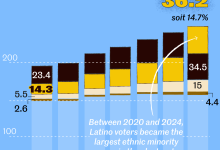To win the Latino Vote, Keep your Promises
The main challenge for the Democrats is to keep the Latino vote, but breaking their campaign promises is not a winning formula to achieve it
In the run-up to November’s midterm elections, and with an eye toward the general elections in 2024, Democrats have a long road ahead to mobilize voters who make up their base. This is in large part because the economic impact of the pandemic, inflation, and Congress’ paralyzation have kept them from being able to offer a list of accomplishments that translates into favorable votes.
Some will say that a lot of what has not happened in Congress is due, in part, to Republican obstructionism. But when the White House and the two chambers of Congress are Democratic, it’s logical for them to be blamed for not fulfilling their promises.
It’s an election year and the hornet’s nest of surveys and focus groups has been kicked over to take stock of voters’ opinions —understand what they think, what bothers them, what worries them, and how all of this will determine their decision to get out and vote, or not, in the coming elections.
Latino vote not cast in stone
And as in each electoral cycle (even if they are later ignored), so begins the typical quest for the so-called Latino vote, whose support for Democrats, according to various polls, has proven not to be written in stone; who can vote in favor of Republican candidates and even former president Donald J. Trump, who improved his margins with Latinos from 2016 to 2020.
Every time an election year rolls around I ask myself whether, finally, both parties—but especially the Democratic Party—will realize that they have to refine their electoral messaging, setting aside the premise that the Latino vote is uniform and, in that vein, applying a uniform message to this community will help with some but alienate others.
That is, the same way they develop messages for different types of voters, whether they are women, African Americans, the LGBTQ+ community, people with college degrees, and people without college degrees, among others, they also have to see Latinos’ wide range of historical, cultural, and national backgrounds. Some are U.S. citizens by birth, others through naturalization.
Latinos can be progressive, liberal, moderate, or conservative; Catholic, evangelical, or atheist; for or against abortion; for or against legalization of undocumented immigrants; pro-government and anti-government; fiscally conservative, capitalist, or socialist; inclusive or racist; in favor or against gender equality; in favor or against the LGBTQ+ community. If there are White supremacists who are Latino, that should be sufficient proof that under the Latino umbrella you’ll find everything under the sun.
The diversity of the Latino vote
This ignorance of our diversity is what has led politicians to apply the same strategy to Latino voters of diverse countries of origin, turning us more into a caricature of what a “Latino voter” is and not what we really are.
It doesn’t have to be so complicated because all of us, Latino or not, are concerned about inflation, the high cost of gas, finding a job that meets our basic needs and those of our families; access to medical coverage when we need it; being able to buy and maintain a home, provide our children with the best education, and even help them pay for college. We want safe neighborhoods, to be able to leave the house without fear of being assaulted or becoming another crime statistic.
We want to live without being victims of racism and prejudice. We want to open our own businesses. And for many of our brothers and sisters, enacting immigration reform to legalize the undocumented is vital: to advance their official integration in the nation to which they have given so much.
In other words, even though it seems difficult, refining an effective message for our diverse Latino community is complicated, but not impossible. Democrats have to take into account that, although our interests are diverse, something we have in common is that we understand perfectly well when we are being taken for a ride, and exactly when things have been promised to us but not actually realized, as is the case with immigration reform.
Latino voters disenchanted
This has disenchanted many Latino voters, so much so that the Democrats have an arduous task ahead, to try to convince Hispanics to continue supporting them. To this apathy, one has to add the wave of disinformation in Spanish on social platforms, as in 2020 when, among other craziness, the idea that President Joe Biden is a “socialist” and has ties to leftist regimes in Latin America, including Venezuela, spread like wildfire in Latino communities, particularly in South Florida.
In sum, the Latino vote is not a block. It is rather fluid, swingy. Democrats continue to be the primary beneficiary of their votes, although Republicans have made some gains and many Latinos, particularly young people, identify more as Independents, tired of the two traditional parties. However, the principal challenge for Democrats is to maintain this support. Failing to accomplish their campaign promises is not a winning formula to do so.
Read the Spanish version of this column here.












